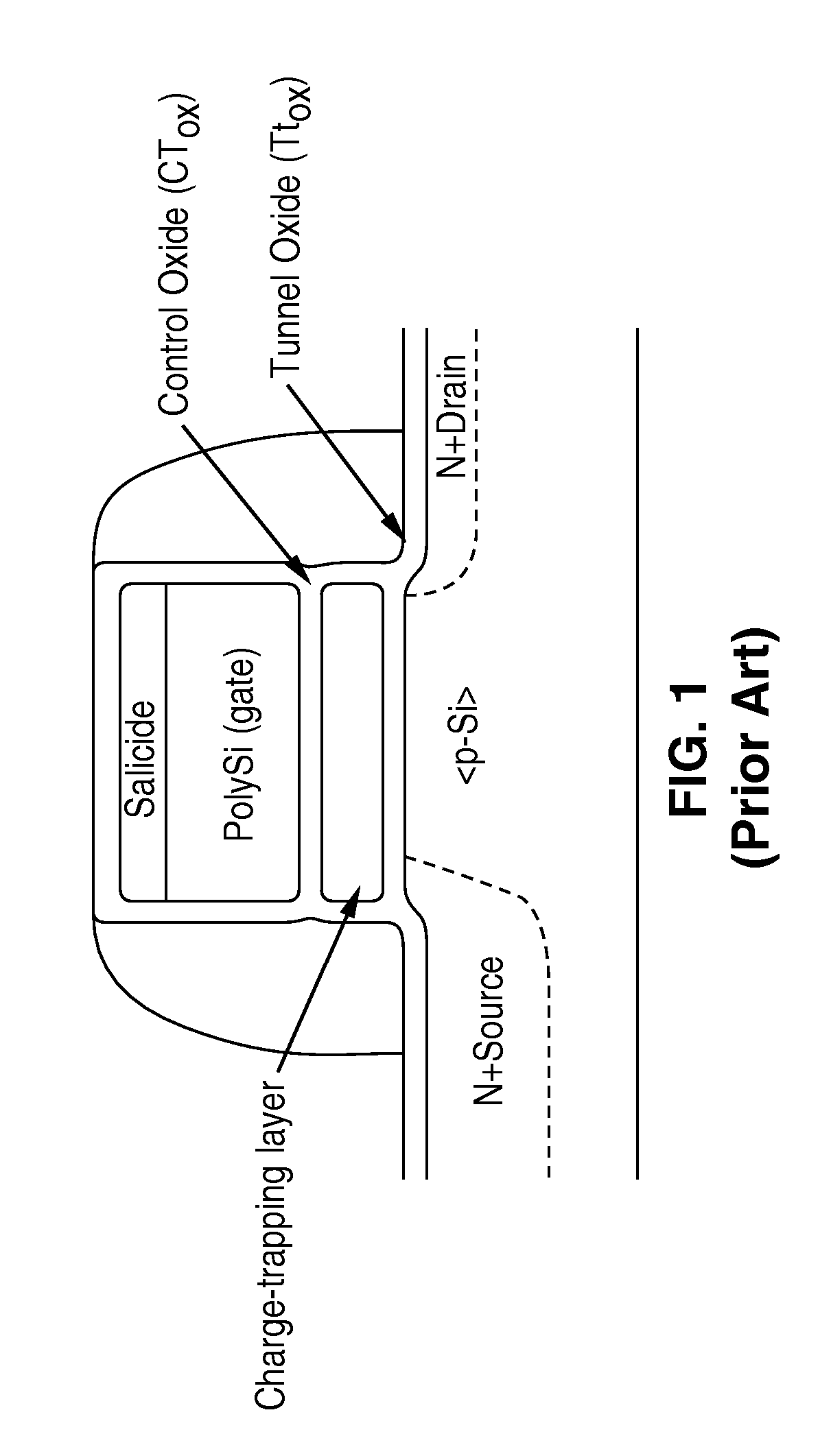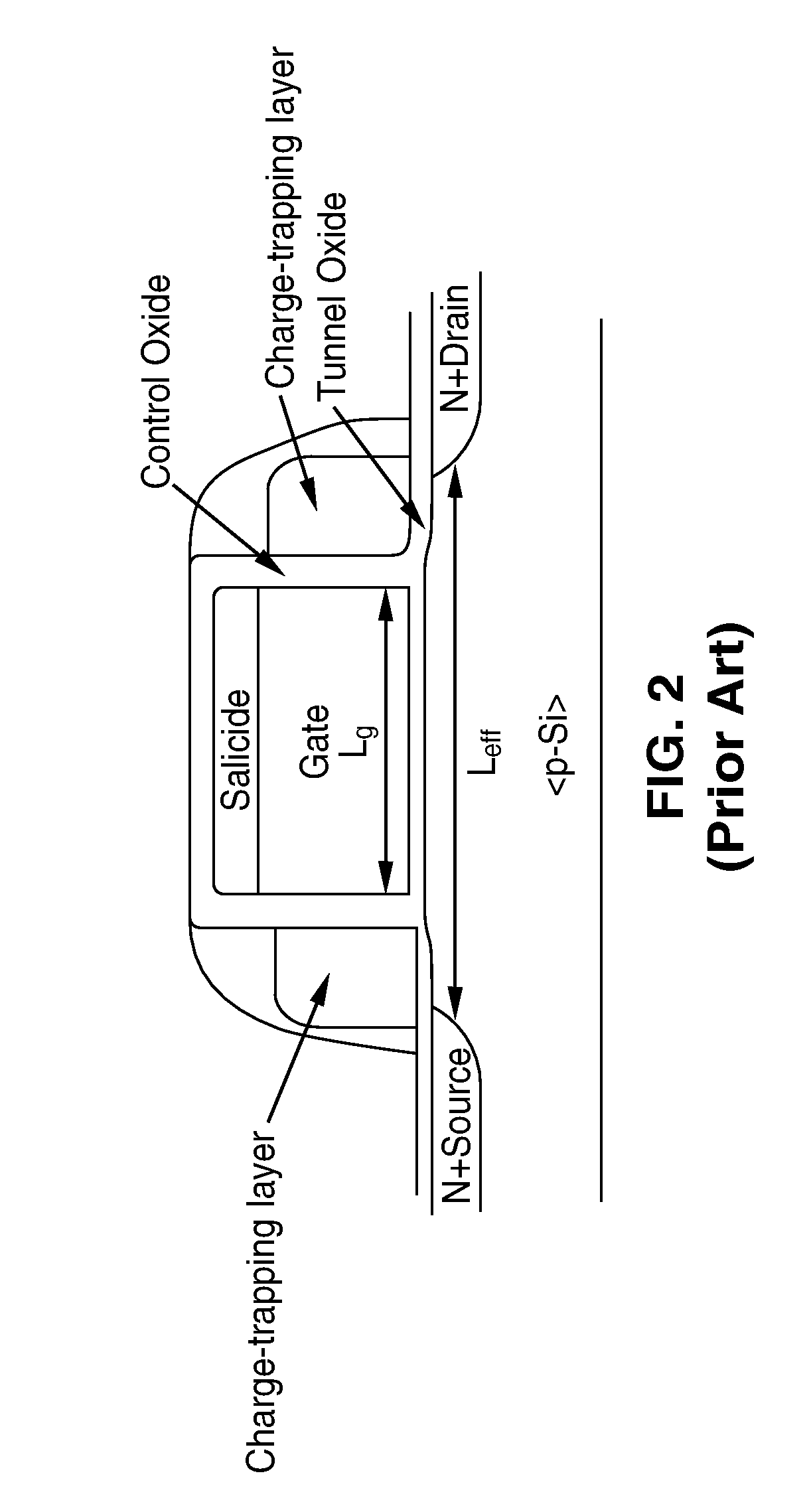Multi-bit-per-cell nvm structures and architecture
a multi-bit, cell technology, applied in the direction of digital storage, semiconductor devices, instruments, etc., can solve the problems of reducing electrostatic integrity, reducing scalability, and difficult scaling of current si floating-gate memory devices to gate lengths below 50 nm, so as to reduce sensitivity to charge, and mitigate against readability variation
- Summary
- Abstract
- Description
- Claims
- Application Information
AI Technical Summary
Benefits of technology
Problems solved by technology
Method used
Image
Examples
embodiment 50
[0102]FIG. 9 through FIG. 11, illustrate an embodiment 50 of the cell structure (FIG. 9-10) and an example array configuration (FIG. 11) for the NOR-type array architecture of FIG. 7. FIG. 9 depicts an XZ plane view of cell 50 while FIG. 10 is a YZ plane view of cell 50. FIG. 11 illustrates a layout (not to scale) in which an array of cells 50 are interconnected to word and bit lines.
[0103] The NVM array structure of FIG. 11 is fabricated on a silicon on insulator (“SOI”) material, which lies on top of a buried oxide (“BOX”) substrate 52, upon which bit lines BL0-BL7 are formed. The FinFET NVM cell 50 is formed on a p-type silicon on insulator (SOI) wafer, where silicon is (epitaxially) grown on top of a buried oxide (“BOX”) film 52 (hence, the term “SOI”). The fin 54 is made of p-type silicon, and bit-lines BL0, BL1 also comprise silicon, except that these are doped with n-type impurities, such as phosphorus, to make them “n-type”. The gate oxide film 60 preferably comprises silico...
embodiment 70
[0110]FIG. 16-19 shows a basic layout (not to scale) of an embodiment 70 of a cell structure (with planar cross-sections) of the unit cell and a NAND-type array architecture 84. As shown, this architecture uses SOI technology, and the unit cell in this architecture is the DG SONOS NVM FinFET cell structure according to an embodiment of the invention, although the architecture applies to structures shown in FIG. 4A-4B.
[0111] A SOI substrate, which lies on top of a BOX layer 72 is used to form each NVM FinFET cell 70. In this embodiment, fin 74 comprises p-type silicon, while bit-lines BL0, BL1 also comprise silicon which is doped with n-type impurities, such as phosphorus, to make them “n-type”. In this double-gated structure, the top of fin 74 is further isolated from the word-line with a thick silicon dioxide film 76, which provides a hard-mask in the manufacturing process of the cell. By way of example, the gate oxide film 82 comprises silicon dioxide (SiO2), and the charge-trappi...
embodiment 90
[0128] A SOI substrate, which lies on top of a BOX layer 92 is used to form this novel NVM FinFET cell 90. The materials and processes for embodiment 90 are described by way of example, and not limitation. Fin 94 comprises p-type silicon, with source electrode 96a and drain electrode 96b comprising silicon doped with n-type impurities, such as phosphorus, to make them “n-type”. The source 96a and drain 96b electrodes of the cell are connected to the memory array bit-lines (BL). This structure contains four ONO gate-dielectric stacks (98, 102, 104, and 106), each stack containing a tunneling silicon dioxide (SiO2) film 100a, which isolates a silicon nitride (Si3N4) charge-trapping region 100b. A silicon dioxide (SiO2) film 100a is used to isolate each charge-trapping film 100bfrom the (n+ PolySi) gate connected to the word-line (WL) of the array, as well as from the source-drain structure connected to the bit-line.
[0129] An exemplary process for fabricating the structure of FIG. 24-2...
PUM
 Login to View More
Login to View More Abstract
Description
Claims
Application Information
 Login to View More
Login to View More - R&D
- Intellectual Property
- Life Sciences
- Materials
- Tech Scout
- Unparalleled Data Quality
- Higher Quality Content
- 60% Fewer Hallucinations
Browse by: Latest US Patents, China's latest patents, Technical Efficacy Thesaurus, Application Domain, Technology Topic, Popular Technical Reports.
© 2025 PatSnap. All rights reserved.Legal|Privacy policy|Modern Slavery Act Transparency Statement|Sitemap|About US| Contact US: help@patsnap.com



